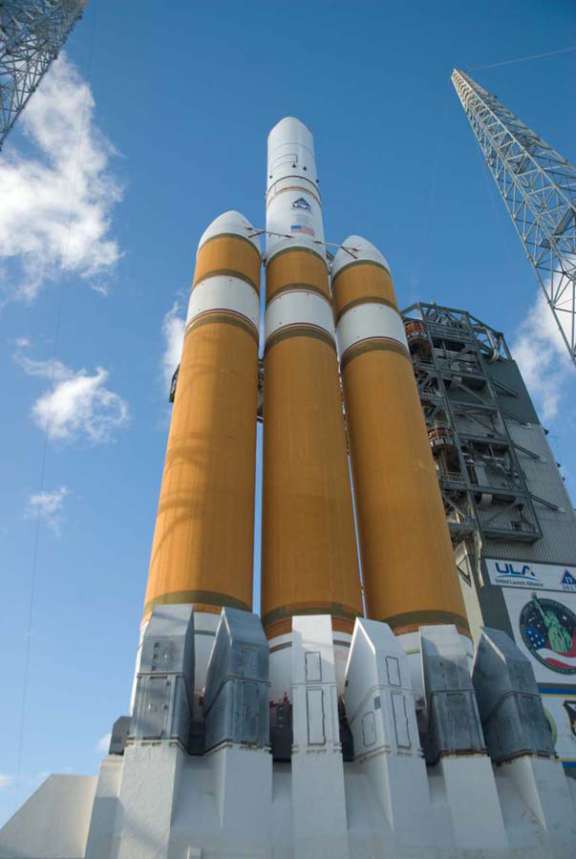Jason Davis • Nov 21, 2011
SLS updates: tower crawl, engine burn and flight test
What's 100 meters tall, weighs 2500 tons, and sparks debates hotter than the exhaust from a recycled space shuttle main engine?
I'm talking about the Space Launch System (SLS), NASA's behemoth next-generation rocket intended to carry humans beyond low-Earth orbit for the first time since the Nixon administration. Critics say the rocket -- which won't fly until 2017 -- is overpriced and siphons precious funding from other space projects. Proponents of the system say it'll be the foundation for the future of human spaceflight.
These arguments, among others about the future of America's space program, aren't likely to be resolved anytime soon. In the meantime, NASA managers and engineers are making progress on the effort to move the SLS from the drawing board to the launch pad.
The pad, in fact, is a great place to start examining the effort. Let's flash back to 2006, when Discovery became the last space shuttle to ride into orbit from Kennedy Space Center's launch pad 39B. Since then, the mobile launcher -- which sits on the behemoth Crawler-Transporter unit and hauls vehicles from the Vehicle Assembly Building -- has received a shiny grey umbilical tower. Originally built for the now-defunct Constellation program's Ares rockets, the launcher's design will be modified to make it compatible with the SLS.

On Wednesday, November 16, the mobile launcher left its parking spot near the VAB for a test drive to pad 39B. During the nine-plus hour trip, engineers executed emergency stops to see how much the new tower sways under duress. The ML and tower are now resting comfortably at the launch pad, which no longer sports the iconic service structure that supported decades of space shuttle launches. The ML will stay at 39B for a couple weeks while engineers perform test connections to water and electric hookups.
Let's leave the pad and head west, where testing is also progressing on the Space Launch System's J-2X engine. On November 9, engineers at Stennis Space Center in Mississippi fired the J-2X for 500 seconds -- its longest burn to date. The J-2X is a redesign of the legacy J-2 engine that powered the upper stage of Saturn rockets during the Apollo program. It combusts liquid hydrogen and oxygen and provides 294,000 pounds (1310 kilonewtons) of thrust during its initial burn, which occurs after first stage separation. That's an upgrade over the J-2's 230,000 pounds (1020 kilonewtons) of first stage thrust. Engineers at Stennis deemed the test a success -- NASA has videos and pictures here.
Perched atop the SLS's upper stage will be the Orion Multi-purpose Crew Vehicle, which is much farther along in development than the SLS itself. In fact, NASA will be ready to take it for a test drive in early 2014 -- using a different rocket. Lockheed Martin, Orion's prime contractor, has selected a Delta IV Heavy for the test. Delta IV rockets are mammoth, three core-rockets capable of hauling 23 metric tons of hardware to low-earth orbit (Orion weighs about 21).
I had a chance to visit Space Launch Complex 6 at Vandenberg Air Force base, the Delta IV's west coast launch site, during the recent NASA NPP Tweetup. I was floored by the size of the facility required to launch these vehicles, and it was difficult to imagine how imposing a fully-fueled Delta IV Heavy must be up close. The Orion test flight -- officially called Exploration Flight Test 1, or EFT-1 -- will launch from Cape Canaveral.

EFT-1 will test Orion's re-entry into Earth's atmosphere at high speeds. NASA will pull this off by using an orbit with an apogee of 8,000 kilometers (the apogee is the highest point of an elliptical orbit around the Earth). Consequently, Orion's re-entry speeds will top 32,000 kilometers per hour.
To put those numbers in context, the highest the space shuttle has ever been was 610 kilometers, during STS-103, a Hubble Space Telescope servicing mission. Orion will not be crewed, but the altitude record for humans in Earth orbit is approximately 1400 km, set during Gemini XI in 1966. Fastest re-entry into Earth's atmosphere? That record is held by Apollo 10 -- 32,000 kilometers per hour. Apollo 10 was on the way back from the moon landing dress rehearsal at the time.
NASA has created a conceptual video of what EFT-1 will look like. After you finish watching the action, crank up the volume (and ignore the sound effects of the rocket -- which wouldn't be audible in space). The soundtrack sounds hauntingly familiar. I've been trying to pin down the reason, and have decided that it sounds somewhat like the end titles of Star Trek: the Motion Picture and Star Trek VI: The Undiscovered Country.
Support our core enterprises
Your support powers our mission to explore worlds, find life, and defend Earth. You make all the difference when you make a gift. Give today!
Donate

 Explore Worlds
Explore Worlds Find Life
Find Life Defend Earth
Defend Earth

